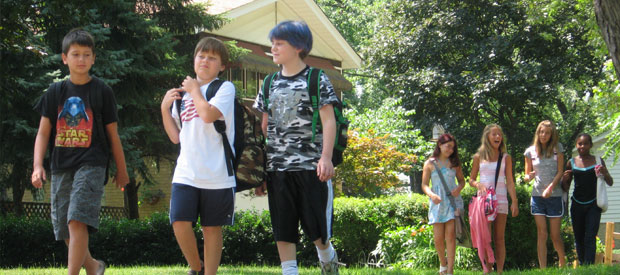
Read about our policy successes with the Safe Routes to School State Network Project.
State policies have a profound impact on the safety, convenience, and ability of children to be able to walk and bicycle to schools. Our detailed briefs will help you assess how these important policies might be improved within your state as they relate to Safe Routes to School issues.
Safe Routes to School State Programs
The federal funds for Safe Routes to School (SRTS) flow from the Federal Highway Administration to the State Department of Transportation (DOT). How the state DOTs set up their programs have a profound impacts on the quality of local SRTS programs and the overall number of students that are being served within the state.
Complete Streets
The planning, design, construction and maintenance of all roadway and transit facilities, as well as developments and new schools, should consider and include the needs of bicyclists and pedestrians from the inception of the project. A Complete Streets policy ensures that local and/or state jurisdictions provide more facilities for safe and healthy physical activity in neighborhoods and on routes to school.
Traffic Safety Training: Walking and Bicycling Programs
Statewide curricula and skills training programs provide for opportunities to integrate Safe Routes to School into school studies and other municipal activities. By inspiring daily physical activity and improving safety, bicycle and pedestrian safety curricula can enhance a community's or local/state jurisdiction's to increase the number and safety of students who walk and bicycle to school.
Fine-Based Mechanisms
Some states have successfully funded local Safe Routes to School programs through fine-based mechanisms such as double-fine zones, and/or additional fees for red-light runners. The key to their success has been the collaboration between legislators, pedestrian advocacy groups and city governments to brainstorm solutions and determine ways to fund pedestrian safety education efforts.
Shared Use of School and Community Facilities
As a strategy for addressing childhood obesity and physical inactivity, communities and school districts can share their recreational facilities after school hours through shared use agreements with their local governments.
Legislation
Advocates can successfully work with state legislators to introduce legislation to create more funding and/or improved policies for Safe Routes to School at the state level. This resource provides insight on implementation of existing laws, and how to work with public agencies that are reluctant to implement a new state law that addresses Safe Routes to School programs and funding.
Lower-income Communities
Children from lower-income families are twice as likely to walk to school as children from higher-income families. It's critical that SRTS funds reach lower-income schools and communities to help improve safety and reduce the higher risks that children from lower-income households face in their route to school. This resource will help state advocates to better work with their State Departments of Transportation and develop proactive policies that will assist the most vulnerable communities in planning for, applying for, and implementing Safe Routes to School grants.
Personal Safety
Although personal safety has steadily improved over the years, many parents are still too worried about the personal safety of their children to allow them to walk or bicycle to school. This resource provides parents and Safe Routes to School advocates with techniques for addressing various personal safety concerns.
School Bus Funding: Cuts and Hazard/Courtesy Busing
School districts throughout the country are struggling to balance budgets and save money. When school districts face financial challenges, a common target for cuts are the school transportation system by cutting back bus routes, trimming the number of bus stops or widening the walk radius around a school. Resources provided here include programs and funding that address cuts and hazard/courtesy busing issues.
School Siting
Only about 35 percent of students in the United States live within two miles of their school. Statewide policies on school siting, acreage requirements, shared use and renovations can profoundly impact the percentage of students who live within walking or bicycling distance of their school. These resources highlight ways to educate decision-makers and state agencies about the benefits of commuity-centered schools, and how to enact policies that protect and encourage better siting of schools that encourage students to walk or ride bicycles safely to school.
Strategic Highway Safety Plans
Each state DOT is required to develop a data-driven Strategic Highway Safety Plan (SHSP) for programming their Highway Safety Improvement fund. Some of this funding can be spent on bicycle and pedestrian safety for school children. SHSPs establish statewide goals, objectives and strategies to address safety needs. These resources provide guidance on ensuring these plans include language that support bicycling and walking improvements and funding.
Federal policies mandate that each school receiving federal aid for school lunches must develop a wellness policy that focuses on nutrition and physical activity. Some states have developed sample wellness policies which provide an important avenue for promoting Safe Routes to School and institutionalizing the program at state and local levels. This resource includes guidance on getting Safe Routes to School language inserted into state model policies.

